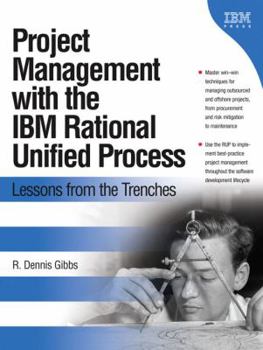Project Management with the IBM Rational Unified Process: Lessons from the Trenches
Master win-win techniques for managing outsourced and offshore projects, from procurement and risk mitigation to maintenance Use RUP to implement best-practice project management throughout the... This description may be from another edition of this product.
Format:Paperback
Language:English
ISBN:0321336399
ISBN13:9780321336392
Release Date:July 2006
Publisher:IBM Press
Length:287 Pages
Weight:1.00 lbs.
Dimensions:0.6" x 7.0" x 9.2"
Customer Reviews
4 ratings
Real World Iterative Project Advice
Published by Thriftbooks.com User , 17 years ago
Iterative Projects require additional attention to planning and re-planning that traditional projects 'do' but not in forced regular intervals - iterations. Some day... a reference will exist with more details on what was actually planned in iterations of a real project. This book is a nice descriptor of the challenges, risks, process, ...
All the instructions needed to understand the basics and progressive steps are included, here.
Published by Thriftbooks.com User , 18 years ago
Any computer user contemplating managing software projects with the IBM Rational Unified Process must have Project Management with The IBM Rational Unified Process: it comes from an author with plenty of background in the system and reviews the program through the entire development cycle, from initial planning to final regular maintenance. Don't think projects have to be large to use this, either: small and medium-sized projects will benefit, as well. All the instructions needed to understand the basics and progressive steps are included, here. Diane C. Donovan California Bookwatch
a coherent process for management
Published by Thriftbooks.com User , 18 years ago
Gibbs writes about how to manage a complex project, subject to various vagaries. The idea is to show how Rational Unified Process can aid the manager. In doing so, the book talks about topics common to any managerial process. Like Change Request Management. Over time, this can get progressively more complex. Sometimes so much so that it can act as a very hinderance to understanding and implementing changes. Mostly, of course, the book educates the reader in RUP. It might simply be that RUP's main merit is in providing a systematic framework for management. After going thru the book, you may not necessarily buy into all that is RUP. But its comprehensive overall structure could give you, the manager, a coherent process to adopt.
With the proper background, there's insight here...
Published by Thriftbooks.com User , 18 years ago
Talk about reading a book that feels like you're reliving your current work assignment... Project Management with the IBM Rational Unified Process - Lessons from the Trenches by R. Dennis Gibbs. Contents: Introduction to Outsourcing; Overview of the Rational Unified Process; Getting Started - Request for Proposals (RFPs), Proposals, and Contracts; Best Practices for Staffing the Outsourcing Organization's Project Management Office (PMO); Best Practices for Staffing the Contractor's Software Project Team; Establishing the Software Development Environment; Inception - Kicking Off the Project; Identifying and Managing Risks; Navigating the Requirements Management Process; Construction Iterations - Staying on Target; Testing; Transitioning a System into Service; System Operations and Maintenance Issues; Using Consultants Effectively; The Project Postmortem; Common Mistakes Utilizing RUP; Implementing a Two-Stage Procurement Process; Glossary; Bibliography; Index I'm in the midst of a specification documentation project, and the organization I work for uses the Rational Unified Process (RUP) standard. The author rightfully states that RUP is adaptable, in that you don't have to adopt absolutely every artifact that RUP contains. You tailor it to fit the organization and the process load you want to undertake. This book is far from a comprehensive guide to everything RUP. Instead, it's more focused on solid project management techniques and processes, and it so happens that RUP is the underlying documentation flow that's used. The other twist you'll see here is that there's an emphasis that you've brought in contractors or you've outsourced your development activity, and Gibbs focuses on how a RUP approach can help overcome many of the difficulties inherent in not controlling every aspect of software development. There's a couple of things I don't quite agree with, however... The author talks about RUP being used in an agile methodology, and states that RUP *can* be agile if you use only what you need. Technically that is probably true, but in reality RUP is a document-heavy methodology that bears little resemblance to agile techniques as they are commonly thought of. Also, chapter 6, Establishing the Software Development Environment, talks about the build/borrow/buy choice for development software. He refers to the "borrow" solution as shareware, when in reality it's open source software. They are two different things, and it makes me wonder how much the guy really knows about software as opposed to project management. If you're in the right scenario of managing outsourced projects using a RUP methodology, this book will offer significant insight. I don't know that I'd recommend it for an introduction to RUP, as you'll probably walk away with a few more questions than answers...






